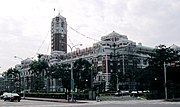|
|
Wikipedia: History of Taiwan
日本队台湾的统治开始于1895, 结束于1945:
http://en.wikipedia.org/wiki/Taiwan#History
短短50年而已。。。英国对香港的占领长达100年,但我认识的全部香港人,不管对大陆有没有看法,至少他们都承认自己是中国人。。。
Excerpt:
European settlement
Main article: Taiwan under Dutch rule
In 1544, a Portuguese ship sighted the main island of Taiwan and dubbed it "Ilha Formosa", which means "Beautiful Island." The Portuguese made no attempt to colonize Taiwan.
In 1624, the Dutch established a commercial base on Taiwan and began to import workers from Fujian and Penghu as laborers, many of whom settled. The Dutch made Taiwan a colony with its colonial capital at Tayoan City (present day Anping, Tainan). Both Tayoan and the island name Taiwan derive from a word in Sirayan, one of the Formosan languages.
The Dutch military presence was concentrated at a stronghold called Castle Zeelandia.[4] The Dutch colonists also started to hunt the native Formosan Sika deer (Cervus nippon taioanus) that inhabited Taiwan, contributing to the eventual extinction of the subspecies on the island.[5]
[edit] Koxinga and Imperial Chinese rule
Main article: Taiwan under Qing Dynasty rule
Naval and troop forces of Southern Fujian defeated the Dutch in 1662, subsequently expelling the Dutch government and military from the island. They were led by Koxinga (traditional Chinese: 鄭成功; simplified Chinese: 郑成功; pinyin: Zhèng Chénggōng). Following the fall of the Ming Dynasty, Koxinga retreated to Taiwan as a self-styled Ming loyalist and established the Kingdom of Tungning (1662–83). Koxinga established his capital at Tainan and he and his heirs, Zheng Jing (traditional Chinese: 鄭經; simplified Chinese: 郑经; pinyin: Zhèng Jīng), who ruled from 1662–82, and Zheng Keshuang (traditional Chinese: 鄭克塽; simplified Chinese: 郑克塽; pinyin: Zhèng Kèshuàng), who served less than a year, continued to launch raids on the south-east coast of mainland China well into the Qing Dynasty, attempting to recover the mainland.
In 1683, following the defeat of Koxinga's grandson by an armada led by Admiral Shi Lang of Southern Fujian, the Qing Dynasty formally annexed Taiwan, placing it under the jurisdiction of Fujian province. The Qing Dynasty government tried to reduce piracy and vagrancy in the area, issuing a series of edicts to manage immigration and respect aboriginal land rights. Immigrants mostly from Southern Fujian continued to enter Taiwan. The border between taxpaying lands and "savage" lands shifted eastward, with some aborigines 'Sinicizing' while others retreated into the mountains. During this time, there were a number of conflicts between Chinese from different regions of Southern Fujian, and between Southern Fujian Chinese and aborigines.
Northern Taiwan and the Penghu Islands were the scene of an important subsidiary campaign in the Sino-French War (August 1884 to April 1885). The French occupied Keelung from 1 October 1884 to 22 June 1885 and the Penghu Islands from 31 March to 22 July 1885. A French attempt to capture Tamsui was defeated at the Battle of Tamsui (8 October 1884). Several battles were fought around Keelung between October 1884 and March 1885 between Liu Ming-ch'uan's Army of Northern Taiwan and Colonel Jacques Duchesne's Formosa Expeditionary Corps. The Keelung Campaign, despite some notable French tactical victories, ended in a stalemate. The Pescadores Campaign was a French victory, but had no long-term consequences. The French evacuated both Keelung and the Penghu archipelago at the end of the war.
In 1887, the Qing government upgraded Taiwan's status from prefecture of Fujian to full province, the twentieth in the country, with its capital at Taipei. This was accompanied by a modernization drive that included building Taiwan's first railroad and starting a postal service.[6]
[edit] Japanese rule
Main article: Taiwan under Japanese rule
 
The building currently known as the ROC Presidential Office was originally built as the Office of the Governor-General by the Japanese government.
Imperial Japan had sought to control Taiwan since 1592, when Toyotomi Hideyoshi began extending Japanese influence overseas. In 1609, the Tokugawa Shogunate sent Arima Harunobu on an exploratory mission. In 1616, Murayama Toan |
|